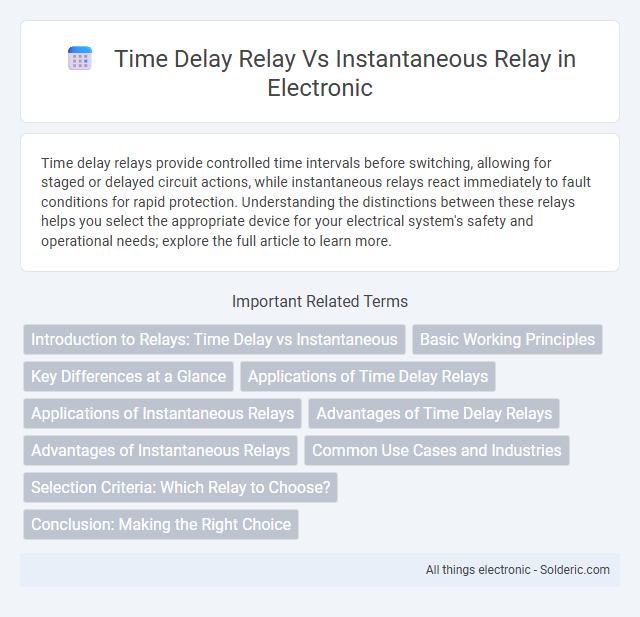Time delay relays provide controlled time intervals before switching, allowing for staged or delayed circuit actions, while instantaneous relays react immediately to fault conditions for rapid protection. Understanding the distinctions between these relays helps you select the appropriate device for your electrical system's safety and operational needs; explore the full article to learn more.
Comparison Table
| Feature | Time Delay Relay | Instantaneous Relay |
|---|---|---|
| Operation Time | Activates after a preset delay | Activates immediately upon signal |
| Application | Motor protection, sequential control | Overcurrent protection, fault detection |
| Trip Characteristics | Adjustable timing to prevent nuisance trips | Immediate trip on fault condition |
| Sensitivity | Less sensitive to transient faults | Highly sensitive to instantaneous faults |
| Use Case | Delays start/stop sequences, avoids transient issues | Provides rapid fault isolation |
| Typical Industries | Manufacturing, automation, HVAC | Power distribution, electrical utilities |
Introduction to Relays: Time Delay vs Instantaneous
Time delay relays provide a controlled delay between input activation and output response, allowing precise timing functions in your electrical circuits. Instantaneous relays, by contrast, respond immediately to input signals, making them ideal for rapid switching and protection applications. Understanding the specific timing requirements of your system is crucial when choosing between time delay and instantaneous relays.
Basic Working Principles
Time delay relays operate by introducing a controlled delay before switching, using an internal timer mechanism to defer activation or deactivation of a circuit after detecting an input signal. Instantaneous relays react immediately to input changes without any intentional delay, responding as soon as the electrical threshold is reached. These fundamental working principles distinguish time delay relays by their ability to manage timing sequences, while instantaneous relays provide immediate circuit response.
Key Differences at a Glance
Time delay relays provide a preset delay before activation or deactivation, enhancing control in sequential operations and preventing nuisance tripping in electrical circuits. Instantaneous relays operate without intentional delay, reacting immediately to fault or trigger conditions, making them ideal for rapid protection and response applications. The key difference lies in their response time: time delay relays offer controlled timing flexibility, while instantaneous relays prioritize immediate action for critical safety and operational functions.
Applications of Time Delay Relays
Time delay relays are widely used in industrial automation, motor control circuits, and lighting systems to introduce intentional delays for sequencing operations or preventing actuator damage. Typical applications include controlling conveyor belts, delay-off functions in HVAC systems, and staggered startup of machinery to reduce inrush currents. By contrast, instantaneous relays provide immediate response for protection and switching tasks where timing delay is not required.
Applications of Instantaneous Relays
Instantaneous relays are widely used in protection systems for electrical circuits needing rapid response, such as motor protection and short-circuit detection. Their ability to trip immediately without intentional time delay makes them ideal for safeguarding transformers, generators, and feeders against severe faults. You benefit from enhanced system reliability and minimized equipment damage due to these swift protective actions.
Advantages of Time Delay Relays
Time delay relays offer precise control in industrial automation by allowing devices to activate after a predetermined interval, reducing wear and preventing false triggering in electrical circuits. These relays enhance system reliability and safety by managing start-up and shut-down processes smoothly, accommodating fluctuating load conditions. Your equipment benefits from extended lifespan and improved operational efficiency when incorporating time delay relays over instantaneous relays.
Advantages of Instantaneous Relays
Instantaneous relays provide rapid response times crucial for protecting electrical circuits from short circuits and overloads, minimizing equipment damage and enhancing system reliability. Their quick operation enables immediate disconnection during fault conditions, reducing the risk of extensive damage and improving overall safety. The simplicity and lower cost of instantaneous relays make them ideal for applications requiring fast fault clearance without delay settings.
Common Use Cases and Industries
Time delay relays are commonly used in industrial automation, HVAC systems, and conveyor controls where precise timing sequences and delayed activation or deactivation prevent machinery damage and ensure safety protocols. Instantaneous relays find prevalent application in electrical protection systems within power generation plants and manufacturing industries to provide immediate circuit interruption during faults and overloads. Both relay types are integral to automotive electronics and telecommunications, optimizing operational efficiency and reducing system downtime.
Selection Criteria: Which Relay to Choose?
Choosing between a Time Delay Relay and an Instantaneous Relay depends on your specific control requirements, such as the need for delayed activation to avoid false triggers or immediate response for critical protection. Time Delay Relays are ideal when a precise interval is necessary before switching actions, enhancing system stability and preventing nuisance trips. Instantaneous Relays suit applications requiring immediate switching, providing rapid fault detection and protection without delay.
Conclusion: Making the Right Choice
Choosing between a time delay relay and an instantaneous relay depends on the specific application requirements such as load sensitivity, response speed, and protection needs. Time delay relays are ideal for applications requiring controlled delays to prevent nuisance tripping, while instantaneous relays provide immediate response critical for fast fault detection. Selecting the right relay enhances system reliability and ensures optimal protection for electrical circuits and equipment.
Time Delay Relay vs Instantaneous Relay Infographic

 solderic.com
solderic.com